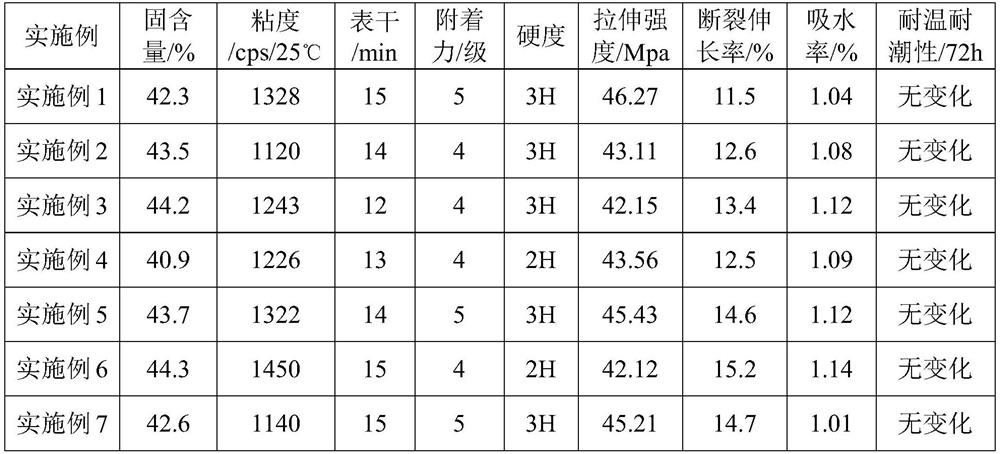A kind of room temperature ketone hydrazine self-crosslinking acrylic resin emulsion and its preparation method and application
A self-crosslinking acrylic and resin emulsion technology, applied in the direction of adhesive types, adhesives, ester copolymer adhesives, etc., can solve the problems of low adhesion of substrates, reduced adhesion, etc., to increase molecular weight, ensure The tear film does not stick to the hand, and the effect of accelerating the drying rate at room temperature
- Summary
- Abstract
- Description
- Claims
- Application Information
AI Technical Summary
Problems solved by technology
Method used
Image
Examples
Embodiment 1
[0030] Add 30g water, 1g initiator sodium persulfate and 0.1g buffer sodium bicarbonate as a bottom solution in a 500mL four-necked flask equipped with a stirrer, condenser, thermometer and water bath, and stir well. 100g water, 30g methyl methacrylate, 10g styrene, 50g butyl acrylate, 10g 5-sulfonyl-1-pentene, 10g diacetone acrylamide, 5g sodium lauryl sulfate, 3.5g Sodium sulfate and 5 g of dodecyl mercaptan were mixed, stirred at a rotation speed of 300 r / min for 30 minutes and mixed uniformly to prepare a pre-emulsion. After the temperature in the flask is raised to 80°C, 10wt% of the above-mentioned pre-emulsion is pre-injected into the flask with the preheated bottom material at one time to serve as the reaction "seed". After about 30 minutes, the bottom of the flask began to glow blue, and then use a peristaltic pump to slowly drip the remaining pre-emulsion into the four-necked flask for about 3 hours; after the addition, the temperature was raised to 85°C and the tempe...
Embodiment 2
[0032] Add 45 g of water, 2 g of initiator ammonium persulfate and 0.5 g of buffer sodium bicarbonate to a 500 mL four-neck flask equipped with a stirrer, condenser, thermometer, and water bath as the bottom solution, and stir well. Mix 80g water, 25g methyl methacrylate, 25g styrene, 70g butyl acrylate, 15g sodium allyl sulfonate, 10g diacetone acrylamide, 1g sodium dodecylbenzene sulfonate, 10g ammonium persulfate, 3g Mercaptoethanol was mixed, stirred at a speed of 600r / min for 30min and mixed uniformly to prepare a pre-emulsion. After the temperature in the flask is raised to 75°C, 10wt% of the above-mentioned pre-emulsion is pre-injected into the flask with the preheated bottom material at one time to serve as the reaction "seed". After about 45 minutes, the bottom of the flask began to glow with blue light, and then use a peristaltic pump to slowly drip the remaining pre-emulsion into the four-necked flask for about 2 hours. After the addition, the temperature was raised ...
Embodiment 3
[0034] Add 30g water, 1g initiator potassium persulfate and 0.2g buffer potassium bicarbonate as the bottom solution in a 500mL four-neck flask equipped with a stirrer, condenser, thermometer, and water bath, and stir well. Mix 100g water, 30g methyl methacrylate, 10g styrene, 50g butyl acrylate, 10g 5-sulfonyl-1-pentene, 5g diacetone acrylamide, 5g dodecyl diphenyl ether disulfonic acid Sodium, 3.5g potassium persulfate, 1g lauryl mercaptan were mixed, stirred for 30 min at a rotation speed of 300 r / min, and mixed uniformly to prepare a pre-emulsion. After the temperature in the flask is raised to 78°C, 10wt% of the above-mentioned pre-emulsion is pre-injected into the flask with the preheated bottom material at one time to serve as the reaction "seed". After about 30 minutes, the bottom of the flask began to glow with blue light, and then use a peristaltic pump to slowly drip the remaining pre-emulsion into the four-necked flask for about 2.5 hours. After the addition, the te...
PUM
| Property | Measurement | Unit |
|---|---|---|
| particle diameter | aaaaa | aaaaa |
| viscosity | aaaaa | aaaaa |
| water resistance | aaaaa | aaaaa |
Abstract
Description
Claims
Application Information
 Login to View More
Login to View More - R&D
- Intellectual Property
- Life Sciences
- Materials
- Tech Scout
- Unparalleled Data Quality
- Higher Quality Content
- 60% Fewer Hallucinations
Browse by: Latest US Patents, China's latest patents, Technical Efficacy Thesaurus, Application Domain, Technology Topic, Popular Technical Reports.
© 2025 PatSnap. All rights reserved.Legal|Privacy policy|Modern Slavery Act Transparency Statement|Sitemap|About US| Contact US: help@patsnap.com

